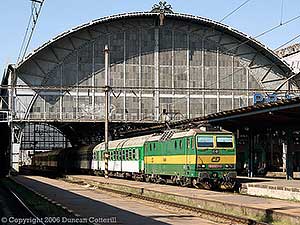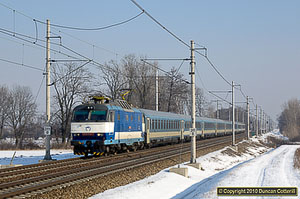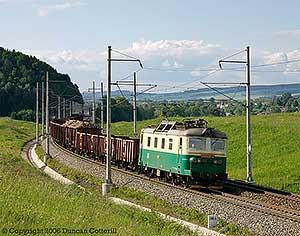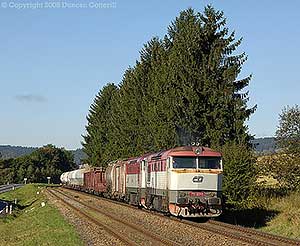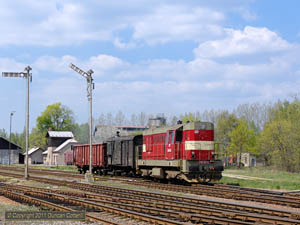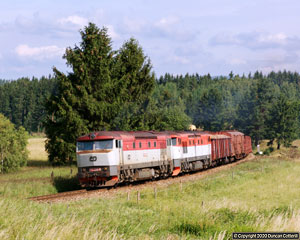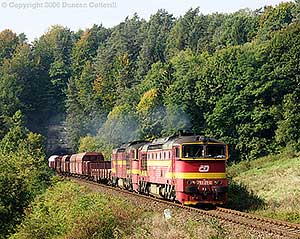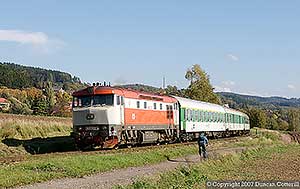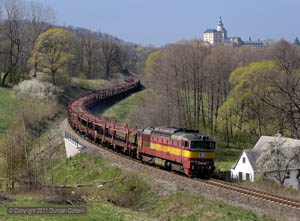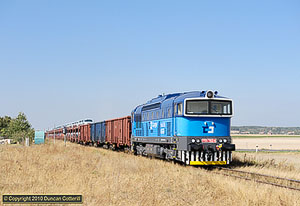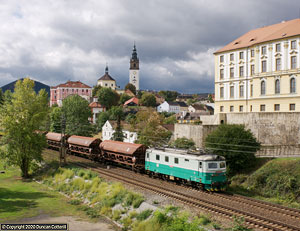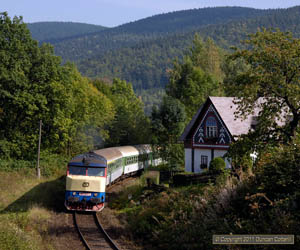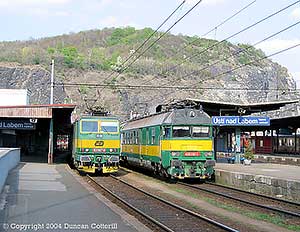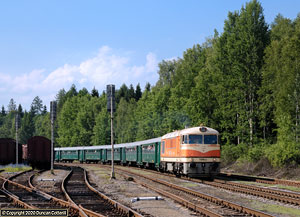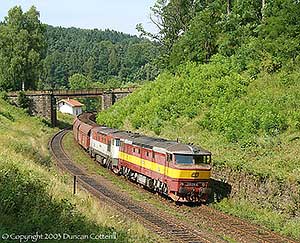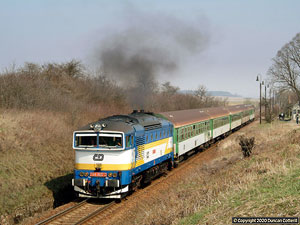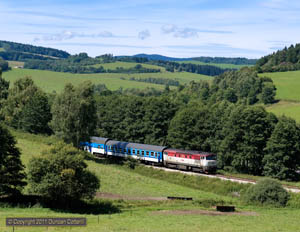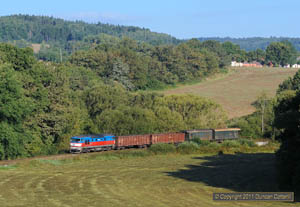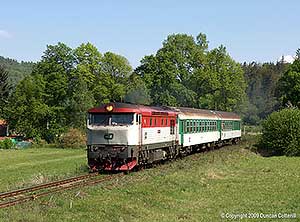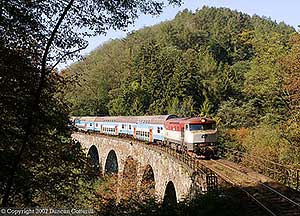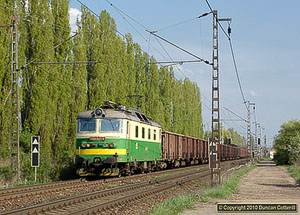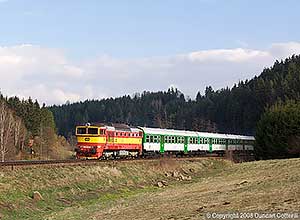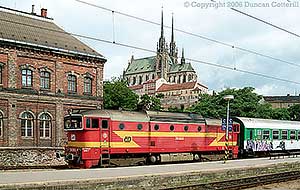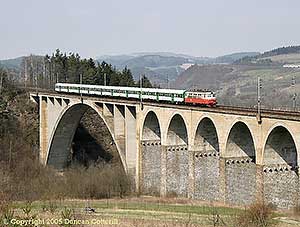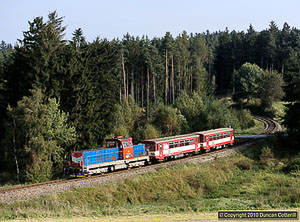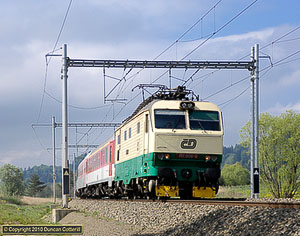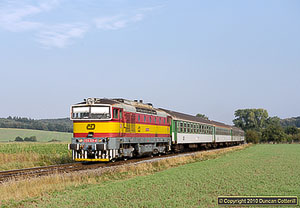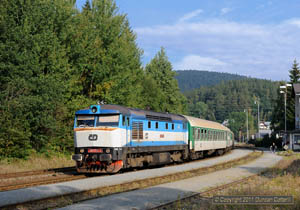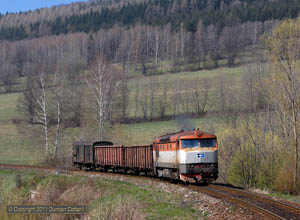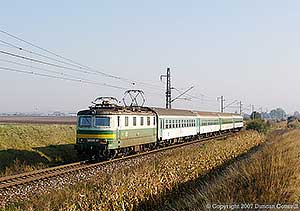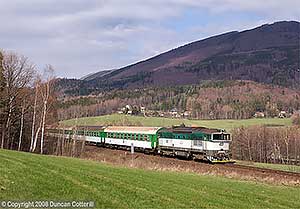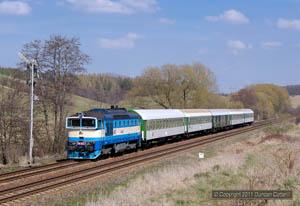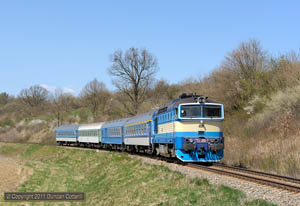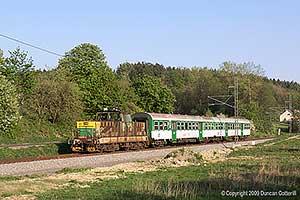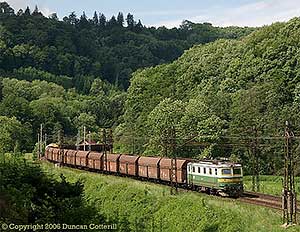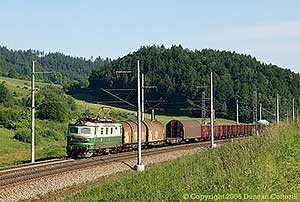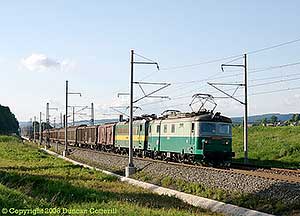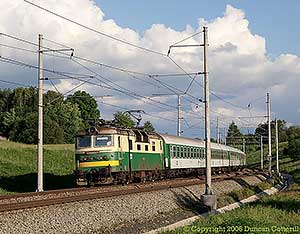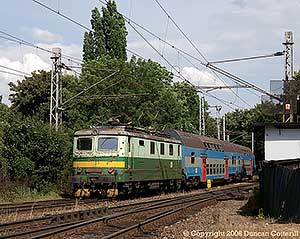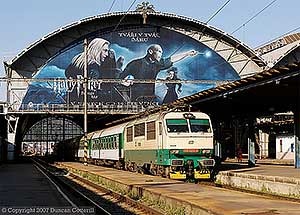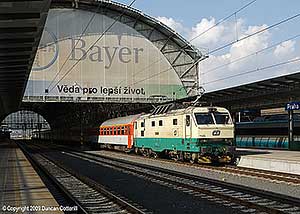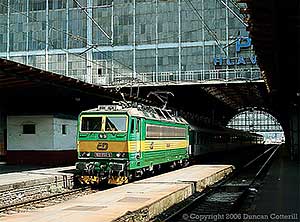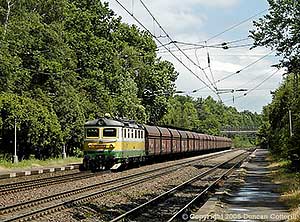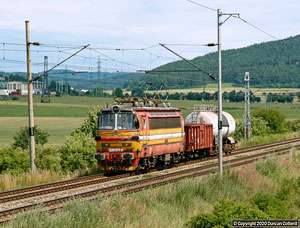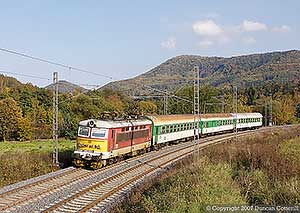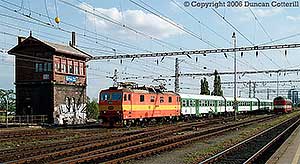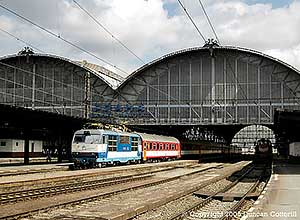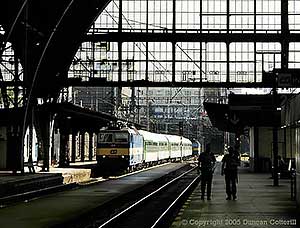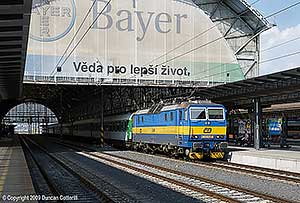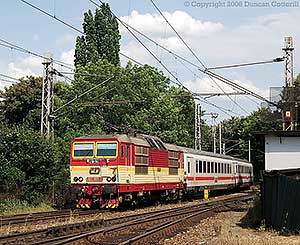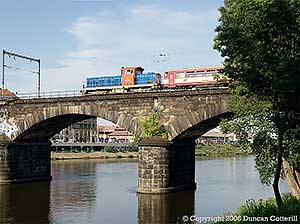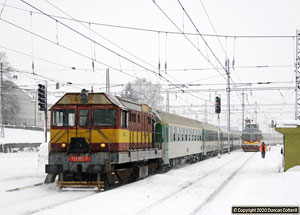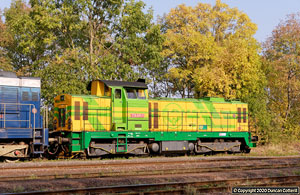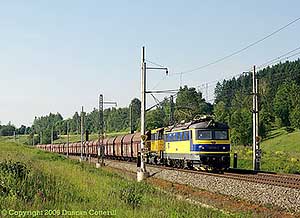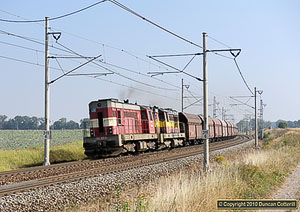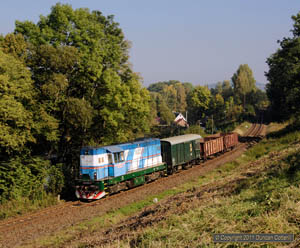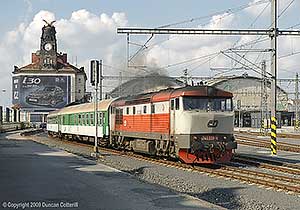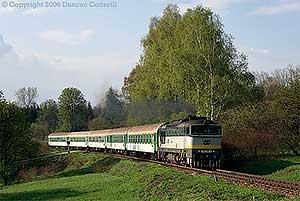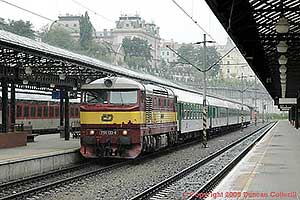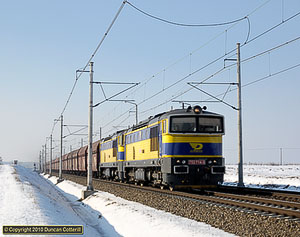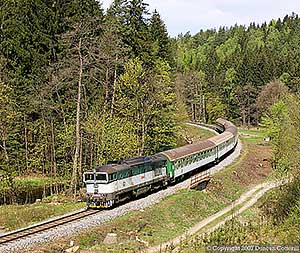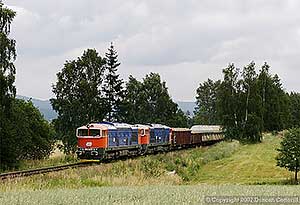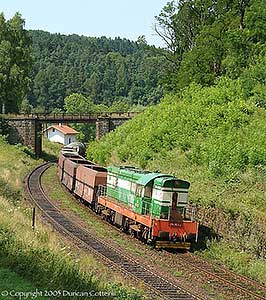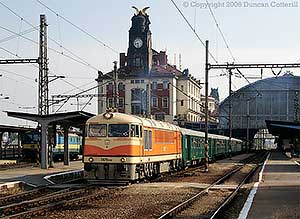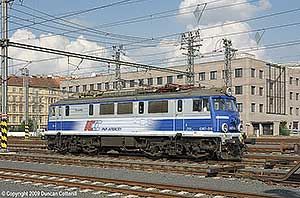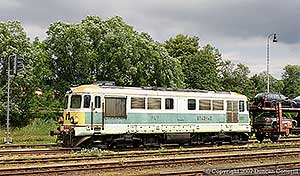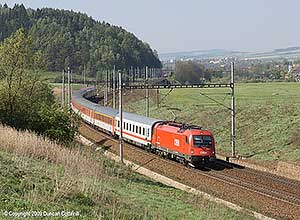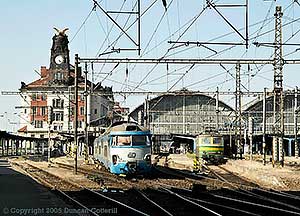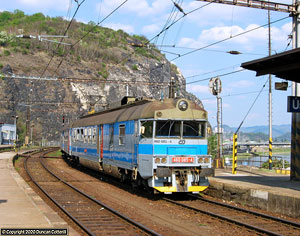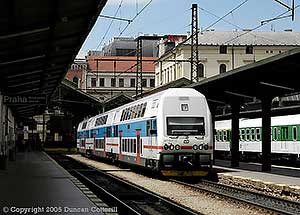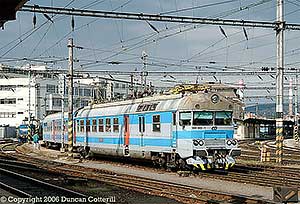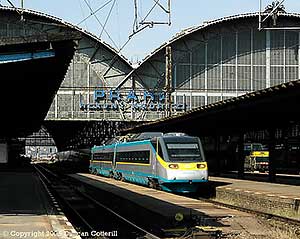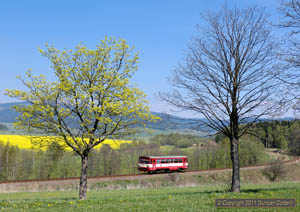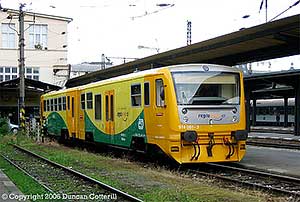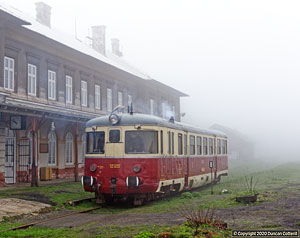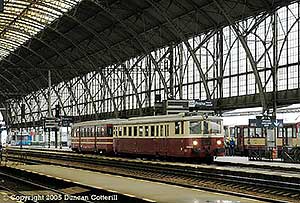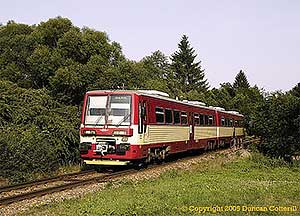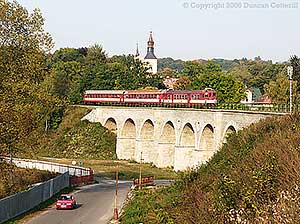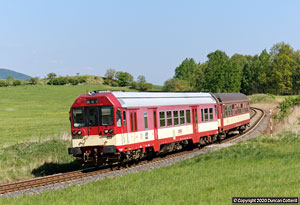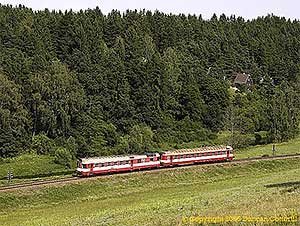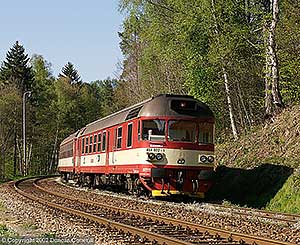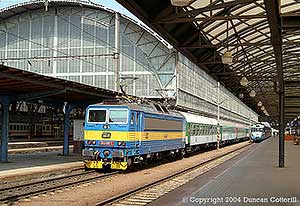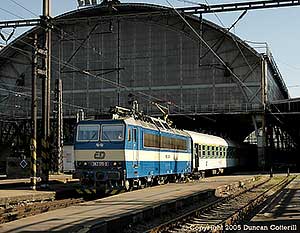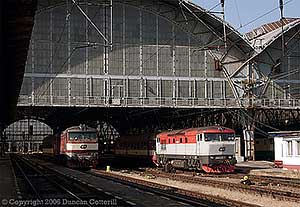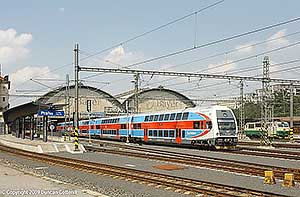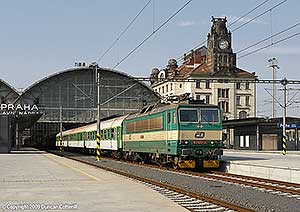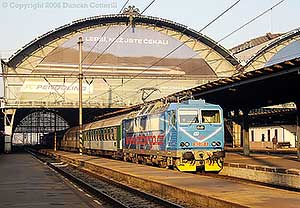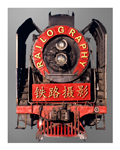000 Praha Area
49 photos
updated : 2020-11-21
Praha (Prague) is the capital of the Czech Republic and the hub of the country's rail system. A wide variety of electric locos and EMUs and a few diesels can be seen in action around the city. There are a number of good photo locations in the area, including the main station with its fine overall roof.
010 Pardubice Area
28 photos
updated : 2020-11-25
The city of Pardubice is located on the electrified main line from Praha to Ostrava and Brno. The rail scene is characterised by heavy passenger and freight traffic worked by a wide variety of classes. Like many Czech towns and cities, you don't have to go very far to find pleasant open countryside.
010 Ceska Trebova Area
33 photos
updated : 2020-11-25
Ceska Trebova is a railway town with a major marshalling yard, locomotive depot and locomotive works, situated at the junction of the electrified main lines from Praha to Ostrava and Brno. Just to the north, the railway threads through a range of wooded hills offering the best scenic locations on the whole line.
021 Letohrad - Lichkov
42 photos
updated : 2020-11-24
Letohrad - Lichkov was one of the last Czech lines with heavy diesel hauled freights. Pairs of Class 751s worked trains from Letohrad to Miedzylesie, over the border in Poland, until the line was electrified in 2008. The line also had Class 749 hauled passengers, attractive scenery and semaphore signals.
025 Dolni Lipka - Hanusovice
3 photos
updated : 2020-11-24
Since the demise of the Praha - Jesenik passenger service this quiet but scenic line has become even more of a rural backwater. At least there was still a pick up goods at the west end of the line to keep the occasional railbus company.
026 Tyniste nad Orlici - Mezimesti
12 photos
updated : 2020-11-25
The line from Tyniste nad Orlici to Mezimesti via Nachod had a number of loco hauled passengers in the early 2000s but by 2007 they were history and only the infrequent freights were loco hauled. There are some excellent photo locations at the north end of the line, between Nachod and Mezimesti.
030 Liberec - Jaromer
9 photos
updated : 2020-11-25
This cross country route runs through some excellent scenery but interesting workings are few and far between. Loco hauled passengers are now limited to occasional railcar substitutions and the weekends only Praha - Tanvald trains but there is some freight traffic between Turnov and Liberec.
032 Jaromer - Trutnov
14 photos
updated : 2020-11-25
Like the Mezimesti line, the south end of this route is fairly featureless but there are plenty of attractive locations between Ceska Skalice and Trutnov. The fast trains on this line were loco hauled when I visited.
037 Liberec - Zawidow
62 photos
updated : 2020-11-27
The scenic Liberec - Cernousy - Zawidow line was a good place to photograph diesel hauled freight trains in the early 2000s. Liberec depot's Class 753 diesels, the last active examples of the class, were regular power for freights until 2010 when Class 753.7 rebuilds took over.
071 Nymburk - Mlada Boleslav
13 photos
updated : 2020-11-27
The Nymburk - Mlada Boleslav line is one of the busiest non-electrified freight routes in the Czech Republic. In addition to through traffic to Poland via Liberec and Zawidow, there are many trains to or from the giant Skoda car plant at Mlada Boleslav. It’s not the most scenic line but there are a few decent positions.
072 Usti nad Labem - Nymburk
4 photos
updated : 2020-11-26
The electrified line from Usti nad Labem to Lysa nad Labem is an important freight artery, linking the the northern coal mining areas and the cross-border line from Dresden with the heart of the Czech system, bypassing the congested Praha area. The route follows the valley of the Labe (Elbe) most of the way.
086 Liberec - Ceska Lipa
35 photos
updated : 2020-11-27
This is one of the most scenic lines in the Czech Republic and has numerous good photo positions, particularly at the Liberec end. The loco hauled passenger trains are now history but there were as many as 12 loco hauled fast trains and a couple of locals every day, plus the occasional freight, in the early 2000s.
090 Praha - Decin
5 photos
updated : 2020-11-27
This electrified main line follows the rivers Vltava and Labe from Praha to the German border, a few km north of Decin. As well as domestic and international passenger traffic, it also sees a reasonable amount of freight. Much of the line is scenically unexciting but there are some pleasant stretches as well.
120 Praha - Rakovnik
13 photos
updated : 2020-11-27
This is one of the few remaining diesel worked routes from Praha and serves the steel town of Kladno on its way to Rakovnik. Some passengers were loco hauled in the early 2000s and the line is a favorite for special trains from Praha. There is a little freight traffic, mainly east of Kladno.
140 Karlovy Vary - Chomutov
29 photos
updated : 2020-11-27
This was CD's last diesel worked trunk route until it was electrified in 2005/6. The line follows the winding Ohri valley from Klasterec to Vojkovice then takes a shortcut over a range of hills to Karlovy Vary. It was a superb line to photograph with double track, semaphore signals at several stations and gorgeous scenery.
180 Plzen - Domazlice
22 photos
updated : 2020-11-26
Plzen's blue, white and yellow class 754s were extremely photogenic and did most of their work in the gently undulating Sumava countryside between Plzen and Domazlice. The line continues over the border to Furth im Wald in Germany and sees several international passenger trains every day.
194 Ceske Budejovice - Nove Udoli
67 photos
updated : 2020-11-22
The Ceske Budejovice to Nove Udoli line runs through some of the finest scenery in the Czech Republic as it winds its way through the Sumava, an upland area with hills, forests, rivers and lakes. In summer there were a number of loco hauled services over the line, worked by class 749 diesels until 2012.
197 Cicenice - Nove Udoli
5 photos
updated : 2020-11-22
The Cicenice to Cerny Kriz line runs into the heart of the Sumava, an upland region close to the German and Austrian borders. It’s a scenic line but passenger traffic is all worked by 4-wheel railbuses. There was also a daily pick-up freight, worked by a class 751 diesel, when I visited in 2009 and 2011.
200 Zdice - Protivin
3 photos
updated : 2020-11-26
The secondary route from Zdice, west of Praha, to Protivin, west of Ceske Budejovice, serves a number of small towns dotted across a gently rolling landscape. It was overgrown with limited access making it difficult to photograph. For a few years it gained a two-hourly Class 749 hauled passenger service.
210 Praha - Cercany
6 photos
updated : 2020-11-24
The line from Praha to Cercany and Dobris runs along the scenic Vltava and Sazava valleys, popular with Praha residents keen to escape the city. Extra services run on summer weekends, with longer trains and more loco haulage.Class 749s on rakes of double deck stock work several Cercany services.
231 Praha - Nymburk - Kolin
14 photos
updated : 2020-11-24
This line isn't scenic but it is busy in the Podebrady area with fast passengers on the Praha - Hradec Kralove and Kolin - Usti nad Labem routes, locals from Praha to Kolin and lots of freight traffic working in and out of the major yards at Nymburk and Kolin. Most of the DC electric classes can be seen here.
240 Brno - Jihlava
30 photos
updated : 2020-11-21
A superb cross country route that winds it's way across the grain of the landscape with plenty of curves and gradients and several major bridges. Brno based class 754s worked many of the passengers. Class 742 locos and veteran class 850 railcars also appeared in the early 2000s
250 Brno Area
14 photos
updated : 2020-11-26
Brno is Czechia's second city, the historic capital of Morava and a major rail centre. Electrified main lines, head north, north-west, north-east and south. Diesel worked lines head west to Jihlava and east to Veseli nad Moravou and saw a good number of services hauled by Brno's colourful Class 754s.
250 Brno - Havlickuv Brod
10 photos
updated : 2020-11-27
For many years this was the principal passenger and freight route from the Austrian and Slovak borders to Praha and beyond. Electrification of the alternative route via Ceska Trebova took away much of the passenger traffic but the bulk of freight traffic remained on the line via Havlickuv Brod.
251 Tisnov - Zdar nad Sazavou
24 photos
updated : 2020-11-24
The passenger service on this scenic rural line was unusually almost 100% loco hauled for years, probably due to the fearsome gradients. The usual Class 714s were joined at weekends by larger diesels of classes 750 and 754. Class 814 DMUs had taken over most services by 2010.
270 Ceska Trebova - Bohumin
7 photos
updated : 2020-11-24
East of Ceska Trebova the electrified main line to the east descends through the Hostejn Gorge to Zabreh na Morave, en route to Olomouc, Ostrava and the Slovakian border. Freight and passenger traffic is heavy and a variety of electric classes can be seen. A new alignment was opened around 2006.
290 Olomouc - Sumperk
8 photos
updated : 2020-11-24
The Olomouc end of this line was operated by a mixture of loco hauled trains and veteran railcars in the early 2000s. It's not a particularly scenic line but the countryside is quite pleasant. The Sumperk end is more scenic but there were fewer trains and most of them were 4-wheel railbuses.
292 Sumperk - Jesenik
129 photos
updated : 2020-11-23
The Sumperk - Jesenik line runs through superb scenery, climbing over the Jeseniky Hory mountains on the way. In the early 2000s it also featured an eclectic mix of motive power including locos of classes 749 and 751 in a variety of liveries and older railcars of classes 831 and 851, all of them now history.
297 Lipova Lazne - Javornik
4 photos
updated : 2020-11-23
A remote rural and scenic branch line that ends within a few km of the Polish border. Passenger services were worked by Class 810 railbuses as might be expected but the pick-up goods trains featured Class 751 diesels, often with a banker. No prizes for guessing which trains are featured here.
301 Olomouc - Nezamyslice
7 photos
updated : 2020-11-25
The countryside around Olomouc could never be described as scenic but it is quite pleasant with open farmland, sleepy villages and gently rolling hills in places. The big attraction here was the use of veteran Class 141 electric locos on most local passenger trains for a couple of years from the end of 2006.
323 Ostrava - Valasske Mezirici
12 photos
updated : 2020-11-25
The Ostrava end of the Valasske Mezirici line probably saw more diesel hauled trains than any other route in the Czech Republic in 2008. The section between Frydlant nad Ostravici and Frenstat pod Radhostem had a reasonable level of loco haulage and a number of excellent photo positions.
340 Brno - Uherske Hradiste
32 photos
updated : 2020-11-24
This line was CD's last diesel worked double track route, with the Brankovice - Kyjov section running through scenic hilly country. Passengers were worked by Class 754 diesels and railcars with the units taking over more services in recent years. The fleet of Class 754s was the most colourful in the country.
341 Stare Mesto - Luhacovice
14 photos
updated : 2020-11-24
This line runs east from Stare Mesto u Uherskeho Hradiste, to the spa town of Luhacovice, with a branch to the Slovak border at Vlarsky prusmyk. Class 754 hauled fast trains ran from Luhacovice to Stare Mesto and there were a few loco hauled peak services from Brno to Bojkovice and Bylnice.
Class 110, 111, 113
4 photos
updated : 2020-11-26
The Class 110 3000V DC Bo-Bo electric was introduced in 1971 and 52 were built for shunting and light line work. Class 113 consisted of 6 similar locos configured to work on 1500V DC lines. The 35 Class 111 followed in 1981 and were broadly similar to the 110s except for being equipped with thyristor control.
Class 121
1 photo
updated : 2020-11-25
The Class 121 3000V DC Bo-Bo electric was a lower geared version of the class 141 passenger loco and was intended for freight traffic. All 85 locos were built in 1960 and in their later years the class was concentrated at Usti nad Labem in the north of the Czech Republic.
Class 122
3 photos
updated : 2020-11-26
The 55 3000V DC Bo-Bo electrics of Class 122 were introduced in 1967 as an updated version of the Class 121 freight locos and have spent their lives working from Usti nad Labem depot.
Class 123
8 photos
updated : 2020-11-26
The class 123 is very similar to the Class 122, with a few relatively minor modifications. These 3000V DC freight Bo-Bos were introduced in 1971 and a total of 29 were built. They are now all based at Usti nad Labem.
Class 130
12 photos
updated : 2020-11-26
The Class 130 electrics are the final iteration of the family of 3000V DC Bo-Bo freight locos that started with the Class 121. The Class was introduced in 1977 and 40 were built for CSD, with another 14 going to industry. Initially based at Ceska Trebova, the whole class is now allocated to Ostrava.
Class 141
10 photos
updated : 2020-11-26
The Class 141 Bo-Bo was introduced in 1959 as a minor development of the earlier Class 140, CSD's first 3000V DC main line electric loco. The 141s were primarily passenger locomotives and remained in front line service until the 1990s with a few surviving into the 21st Century on less demanding duties.
Class 150
4 photos
updated : 2020-11-25
The 27 Class 150 3000V DC Bo-Bo electrics were introduced in 1978 as a DC only version of the dual system Class 350 for express passenger work.
Half the class were upgraded for 160km/h running, becoming Class 151. The remaining Class 150s were later upgraded to 140km/h maximum speed.
Class 151
16 photos
updated : 2020-11-25
Class 151 was formed by re-gearing 13 Class 150 3000V DC Bo-Bo electrics for a maximum speed of 160km/h. They were intended to work the fastest expresses on the route east from Praha through Olomouc to Ostrava and on to Zilina and Kosice in Slovakia, which is where they can still be found at work.
Class 162
10 photos
updated : 2020-11-25
The Class 162 is a 3000V DC Bo-Bo electric loco introduced in 1991 and geared for 140km/h running. Otherwise they're the same as Class 163s and some have been converted to 163s by fitting slower geared bogies from Class 363s. The remaining Class 162s can still be found on express passenger work.
Class 163
18 photos
updated : 2020-11-26
Class 163 is the 3000V DC only version of the dual-system Class 363 mixed traffic Bo-Bo. Although 111 entered service with CSD between 1984 and 1992, the number in service has increased over the years as Class 162s have been fitted with slower geared bogies, converting them to 163s.
Class 181, 182
3 photos
updated : 2020-11-25
Classes 181 and 182 were 3000V DC Co-Co freight electrics. A total of 318 were built between 1961 and 1965. They were notoriously unkind to the track and most were withdrawn in the early 2000s, leaving a handful on banking duties on the line to Cadca. Many withdrawn locos have been sold to Poland.
Class 230, 240
4 photos
updated : 2020-11-27
The 110 Class 230 25kV AC Bo-Bos were CSD's first production AC electrics, built in 1966-67. Next came 145 similar Class 240s in 1968-70. The 230s and 240s were unusual for the extensive use of fibreglass in their construction, hence their nickname 'Laminatka'. CD's locos are now confined to freight traffic.
Class 242
6 photos
updated : 2020-11-26
Although they are very different in appearance, the 242s are technically similar to the class 240s but differ in having a conventional steel body. In total 86 were built between 1976 and 1981 and the class is currently based at Brno and Plzen depots for working passenger services.
Class 263
1 photo
updated : 2020-11-26
Class 263 is a 25kV AC only Bo-Bo electric, closely related to the dual system class 363 and DC Class 163. Only 12 were built, 2 prototypes in 1984 followed by a further 10 examples in 1988. Only the first two remained with CD after partition, working passenger services from Brno.
Class 350
17 photos
updated : 2020-11-26
Skoda built 20 class 350 dual system Bo-Bo electrics between 1974 and 1976. They were the first CSD locos capable of 160km/h and intended for Praha - Bratislava expresses. All 20 went to Slovakia at partition but they continued to run to Praha in return for CD's 150s running to Kosice in eastern Slovakia.
Class 362
7 photos
updated : 2020-11-26
The Class 362 is the express passenger version of the Class 363 dual system Bo-Bo electric. Only one Class 362 was built new, in 1990, the rest have been created since 1999 by fitting class 363s with 140km/h bogies. CD now has around 60 Class 362s, used on most routes that cross the AC/DC divide.
Class 363
14 photos
updated : 2020-11-26
The Class 363 25kV AC/3000V DC Bo-Bo was the first of a large group of electric locos. The class went into series production in 1984, designed for mixed-traffic use, particularly on routes that involve both electrical systems. Several have been converted to Class 362 by fitting bogies from Class 162s.
Class 371, 372
4 photos
updated : 2020-11-21
The Class 372 Bo-Bo electric is a dual system Bo-Bo, similar to the Class 363 but for working from 3000V DC or 15kV AC on trains to Germany via Bad Schandau. A total of 16 were built for CSD between 1988 and 1991. Six locos were later modified for 160km/h running by CD and reclassified as Class 371.
Class 714
20 photos
updated : 2020-11-25
Class 714 are steeple-cab Bo-Bo diesel-electrics, built 1992-97, combining the frames and running gear of redundant single-engined Class 735s with two new 400hp engines and auxiliaries housed in a modular superstructure. The 714s were mainly used on local passenger services in the early 2000s.
Class 720, 721
1 photo
updated : 2020-11-25
Class 720 consisted of 233 end-cab 740hp Bo-Bo diesel electrics built 1958-61, 150 for CSD and 83 for industry. Another 283 locos built to a modified design in 1961-68 became Class 721. All but a handful have been withdrawn but a few have been retained as 'shed pets' and see occasional use.
Class 730
2 photos
updated : 2020-11-27
Class 730 Bo-Bo diesel-electrics were fairly elusive in CD service, being mostly limited to shunting. Only 59 were built in 1978-89 and many went into industrial service. They were intended to replace the ageing Class 720 and 721 but never really caught on. Most of CD's locos have been withdrawn or sold.
Class 740
3 photos
updated : 2020-11-25
CKD developed the Class 740 1180hp Bo-Bo diesel-electric for industrial use, building over 400 between 1973 and 1989. Many remain in service today and they can sometimes be seen on the main line, working for private operators. CD's Class 742s are a development of the Class 740 for main line use.
Class 742
47 photos
updated : 2020-11-26
The Class 742 1180hp Bo-Bo diesel-electric was developed from the Class 740 to meet CSD's requirements. Almost 500 were built in 1977-86, with CSD taking the vast majority. They can be found on shunting, light passenger and freight duties and, in pairs, on heavier freight trains all over the CD system.
Class 743
6 photos
updated : 2020-11-23
The Class 743 Bo-Bo diesel-electric was a development of the ubiquitous Class 742 and differed mainly in having improved brakes for working steeply graded lines. Only 10 743s were built in 1987-88 and for many years the whole class was based at Liberec before going to Nymburk and Ceske Budejovice.
Class 749
164 photos
updated : 2020-11-26
Class 749 was created by converting 34 Class 751 Bo-Bo diesels and 26 similar Class 752s to ETH between 1992 and 1996. At the turn of the 21st Century class 749s could be found working passenger services on a number of secondary lines but by the end of the decade most of their work had gone.
Class 750
37 photos
updated : 2020-11-26
Class 750 consisted of Class 753 Bo-Bo diesels fitted with an ETH generator between 1991 and 1995. A total of 163 were converted and CD ended up with 117 after the breakup of Czechoslovakia. By the turn of the 21st Century the remaining 750s were largely relegated to standby status, covering for failures
Class 751
61 photos
updated : 2020-11-25
The Class 751 1480hp Bo-Bo diesel-electric was introduced in 1964 to meet CSD's need for a medium powered passenger locomotive. Most of the 230 751s became freight locos with the end of steam heat but some were fitted with ETH, becoming Class 749. Most 751s are now withdrawn.
Class 753
22 photos
updated : 2020-11-25
The Class 753 1780hp Bo-Bo diesel-electric was a development of the Class 751, again intended for passenger work. A total of 408 were built in 1968-77. Many were fitted with ETH in the 1990s, becoming Class 750. The remaining 753s continued working freight but most were withdrawn by 2005.
Class 753.7
15 photos
updated : 2020-11-26
Class 753.7 comprises Class 753 Bo-Bo diesel-electrics rebuilt by CKMS with a 1950hp Caterpillar engine. The first examples were exported to Italy in 2001. More were taken by independent Czech operators from 2002 before CD Cargo placed an order for 30 in 2008, enabling it to replace many older diesels.
Class 754
130 photos
updated : 2020-11-26
Class 754 was the final development of the 'Brejlovic' Bo-Bo design, built new with electric train heating. A total of 86 entered service with CSD and CD retained the majority after 1993. They are still active, working many of the remaining loco hauled passenger services on non-electrified lines.
Class 755
5 photos
updated : 2020-11-27
Class 755 is to all intents and purposes the same as class 753.7 and consists of the two prototype 753.7s rebuilt by CMKS for CD in 2005. They were only prototypes from CD's perspective as CMKS had already produced a number of 753.7s for other operators.
Class 770, 771
1 photo
updated : 2020-11-25
Class 770 was CSD's version of the ChME3 Co-Co diesel-electric built in quantity for the USSR. CKD built 108 for CSD in 1963-69 with more for industry. Class 771, built in 1969-72 was a modified version of which CSD got 194. Most were withdrawn years ago but a few 771s still survived into the 2000s.
Class 775, 776
3 photos
updated : 2020-11-25
Class 775 and 776 1970hp Co-Co diesel-electrics were built in 1961-65 and were CSD's first main line diesel design. The main difference between the two classes was that the 776 was equipped with a steam heating boiler. A total of 17 775s and 27 776s were built before production ceased.
Class EU07 (PKP)
2 photos
updated : 2020-11-22
PKP's EU07 Bo-Bo electrics can trace their ancestry back to the English Electric AL3, later Class 83, built for BR in 1960-62. EE then supplied 20 Class EU06, based on the AL3 design to PKP. The EU07 was a Polish development of the EU06 and almost 500 were built from 1965-94.
Class ST43 (PKP)
1 photo
updated : 2020-11-25
The PKP Class ST43 2070hp Co-Co diesel-electric is the same design as the Romanian class 060DA and 422 were built for PKP in 1965-78. Most ST43s have now been withdrawn but they were still used on cross border freight traffic from Mezimesti to Mieroszow in 2007.
Class 1216 (ÖBB)
2 photos
updated : 2020-11-25
The Siemens ES 64 U4 8600hp Bo-Bo electric locomotive, better known as the Austrian Class 1216, is capable of working off 25kV AC, 15kV AC and 3000V DC electrical systems. ÖBB's Class 1216s have been regular power for international services between Wien and Praha since 2009.
Class 451, 452
7 photos
updated : 2020-11-26
Fifty one Class 451 4-car 3000V DC EMUs were built in 1964-68 for working Praha suburban services, followed by 11 very similar class 452 in 1972-73. Trailer cars were moved between sets resulting in some units running as 5 or 6 car formations, while others only had 3 cars. The last unit was withdrawn in 2018.
Class 460
2 photos
updated : 2020-11-27
The first class 460 5-car 3000V DC EMU was built in 1971 with another 42 following in 1974-78. The CD units were concentrated around Usti nad Labem and Ostrava but from around 2005 the whole class was based in the east of the country, in the Ostrava and Olomouc areas.
Class 471
5 photos
updated : 2020-11-25
Class 471 was CD's first modern 3000V DC EMU design, intended for suburban services but increasingly used on longer distance stopping services, such as Praha to Pardubice or Decin. A total of 83 3-car units were built in 1997-2013. The vast majority are based at Praha with a few working from Ostrava.
Class 560
4 photos
updated : 2020-11-26
The first class 560 25kV EMU was built in 1967 with series production following in 1970-71. In total 17 5-car sets were built with CD's units later expanded to 6-cars. They were notable for being the first thyristor controlled traction on CSD.CD's 560s were based at Brno until their recent withdrawal.
Class 680
4 photos
updated : 2020-11-25
CD received seven Class 680 7-car 'Pendolino' tri-system EMUs in 2003-05. Their use on international services to Wien and Bratislava didn't last long and they have been concentrated on premium fare services on the Praha - Ostrava and Praha - Cheb routes in recent years
Class 809, 810, 811
15 photos
updated : 2020-11-27
Class 810 4-wheel railbuses could once be seen almost everywhere on the CSD system. A total of 680 were built between 1973 and 1984 for use on lightly trafficked branch lines and stopping services on quieter secondary routes. Classes 809 and 811 were formed from modified Class 810s.
Class 814
6 photos
updated : 2020-11-24
Class 814 units were created from extensively modernised Class 810 4-wheel railbuses and their Class 010 trailers, forming 2 or 3-car DMUs. The first Class 814 appeared in 2006 and more quickly followed. There are now approximately 250 in service, a mixture of 2 and 3 car units.
Class 820
2 photos
updated : 2020-11-27
Class 820 consisted of 122 diesel-hydraulic railcars built in 1963-64 for local services, including on the Tanvald - Korenov line, for which they were fitted with track brakes. They weren't the most reliable units and the first withdrawals took place as early as the 1980s. By 2002 they had no regular work.
Class 830, 831
20 photos
updated : 2020-11-26
A total of 238 Class 830 diesel-electric railcars were built from 1949 to 1960 for main line services. They were later displaced to less important duties but some survived until 2008. Around 40 were re-engined between 1981 and 1991, becoming Class 831, some of which lasted into 2010.
Class 835
1 photo
updated : 2020-11-21
There was only one Class 835 and that's probably just as well. The unit was built by Metrovagonmash in 2003 and the idea was that Russia would pay its outstanding debts to the Czech Republic with a fleet of these DMUs. Fortunately the deal fell through and the trial unit quickly disappeared.
Class 842
10 photos
updated : 2020-11-26
The two prototype class 842 railcars were built in 1989 with twin diesel engines and hydraulic transmissions. A further 43 followed in 1993-94. They are widely distributed around the network, working stopping and fast trains on secondary lines, usually with one or more trailers in tow.
Class 843
7 photos
updated : 2020-11-27
The 31 Class 843 motor coaches built in 1995-97 marked a return to diesel railcars with electric transmission for the first time since the Class 830s. The 843s can usually be found working fast trains on secondary lines across the country. Some are paired with class 943 driving trailers, removing the need to run round.
Class 850, 851
22 photos
updated : 2020-11-24
The first two class 850 diesel-hydraulic railcars were built in 1962 but it was 1967 before another 50 were built. The similar Class 851 followed, with 37 built in 1968-69. They were intended for express passenger work but were relegated to more menial duties later. All had been withdrawn by 2014
Class 852, 853, 854
23 photos
updated : 2020-11-25
CSD introduced 25 Class 852 and 35 Class 853 diesel-hydraulic railcars for use on expresses between 1968 and 1971. Both classes were unreliable and from 1997 to 2006 a total of 50 were modernised and fitted with Caterpillar engines becoming Class 854, intended for fast services on secondary lines.
Loco Hauled Passengers
460 photos
updated : 2020-11-26
Most long distance passengers are still loco hauled and it's also possible to find locos on local services on the electrified network, although the number of EMUs is increasing. Diesel haulage is largely restricted to a few routes with heavy traffic levels or working through coaches on long distance routes.
Freights
190 photos
updated : 2020-11-27
Freight traffic dropped dramatically after the fall of the iron curtain and the deregulation of road transport in the early 1990s. There are still significant levels of freight on several corridors but, away from the electrified main lines, it can be sparse and diesel worked freights are relatively hard to find.
AC Electrics
10 photos
updated : 2020-11-27
Several of the country's most important routes had been electrified at 3000V DC before 25kV AC was adopted for new schemes in the late 1960s. Relatively few major routes are AC all the way and dual-system locos have been preferred. Several classes of AC only loco were built and are still in service.
DC Electrics
90 photos
updated : 2020-11-26
CSD electrified several major routes at 3000V DC from the 1950s onwards, before switching to 25kV AC as the preferred system in the late 1960s. Most DC electrics date from the 1970s or later but a few early examples still see some use. Polish and Slovak DC electrics can also be seen on Czech rails.
Multi System Electrics
44 photos
updated : 2020-11-26
Czechoslovakia electrified much of its network at 3000V DC before switching to 25kV AC in the late 1960s. Some routes involve both voltages and dual system designs were introduced from the 1970s. More recently standard multi-system designs from Siemens and Bombardier have also been used.
Diesels
515 photos
updated : 2020-11-27
In the early years of the 21st Century there was still a lot of work for diesels in the Czech Republic. There weren't many different types but the variety of liveries was unmatched anywhere in Europe. Diesel working is less common these days but the photos here were taken while it was still good.
EMUs
22 photos
updated : 2020-11-27
Until the early years of the 21st Century the only EMUs in the Czech Republic were used on suburban duties around some of the main centres such as Praha and Brno. The first Pendolinos arrived in 2005 and several other classes for regional services have followed since (although they're not featured here).
Diesel Motor Coaches
84 photos
updated : 2020-11-27
Instead of DMUs, CSD traditionally built diesel motor coaches to work fast and semi-fast services on unelectrified main and secondary lines. They were designed to haul a number of trailers but had to run round their trains like a loco at termini as there were no driving trailers until fairly recently.
CD Cesky Drahy
659 photos
updated : 2020-11-27
CD is the national operator responsible for most passenger services in the Czech Republic. It operates the majority of services on most lines, from rural branches to electrified international routes. CD has a large and varied fleet of diesel and electric locomotives, EMUs, DMUs and diesel motor coaches.
CD Cargo
75 photos
updated : 2020-11-26
CD Cargo is the freight arm of Cesky Drahy, operated as a semi-independent subsidiary since late 2007. It still runs the majority of freights on the Czech system despite the arrival of foreign and independent operators. CD Cargo operates a large and varied fleet of electric locos with a smaller diesel fleet.
Independent & Industrial Operators
8 photos
updated : 2020-11-27
There are now a number of independent or industrial operators running their own locomotives or units on the Czech system. They cover the whole gamut of operations from inter city passenger to short freight hauls and use a wide range of traction including some classes long extinct from CD's roster.
Preserved
8 photos
updated : 2020-11-27
There is an active preservation scene in the Czech Republic with preserved locos and railcars regularly running on the national system. As well as enthusiast groups, depots or railway staff groups also adopt locos and keep them in working order. Others are owned by the National Technical Museum.
ZSSK
19 photos
updated : 2020-11-26
There is a high degree of commonality between the Czech and Slovak loco fleets and co-operation between ZSSK and CD sees Slovak locos working to Praha while Czech locos work deep into Slovakia. Slovak Class 350s are regular visitors to Praha while Classes 162 and 362 can also be seen on occasion.
The Czech Republic, a.k.a. Czechia, is a small country full of railway interest, with an attractive landscape, a variety of traction and, at one time, an almost infinite multiplicity of liveries. Sadly, modernisation is now taking its toll, making the railway more efficient and less interesting every year.




 options
options hide options panel
hide options panel